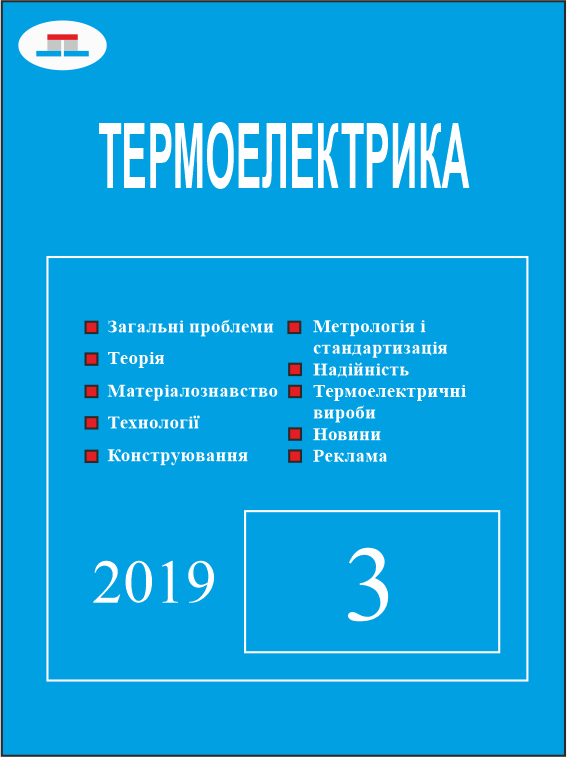Теорія середнього поля для термоелектричних властивостей композитних матеріалів з різними порогами протікання
Ключові слова:
термоелектрика, теорія протікання, поріг протікання, композити, ефективні властивостіАнотація
В роботі побудовано модифіковану теорію ефективного середовища для обчислень ефективних кінетичних коефіцієнтів термоелектричних композитів з різними значеннями порогів протікання. Показано, що навіть за концентрацій поза критичною областю величина порогу істотна для визначення ефективних властивостей. Розглянуто два принципово різних випадки набору локальних властивостей композиту. Один з них, коли провідність і теплопровідність однієї з фаз одночасно більша за провідність та теплопровідність другої фази. Другий, аномальний випадок, коли електропровідність першої фази (σ1) більша від другої, але теплопровідність першої фази менша від другої, показує незвичайну концентраційну поведінку ефективної провідності, тобто при зростанні частки добре провідної фази ефективна провідність демонструє зменшення, а не зростання як у стандартному випадку, див. рис. 1а), яке при p ≈ pc переходить в зростання. Бібл. 20, рис. 5.
In the work, a modified effective medium theory is constructed for calculating the effective properties of thermoelectric composites with different values of percolation thresholds. It is shown that even at concentrations beyond the critical region, the threshold value is essential for determining the effective properties. Two fundamentally different cases of a set of local properties of the composite are considered. In one of these cases, the conductivity and thermal conductivity of one of the phases is simultaneously greater than the conductivity and thermal conductivity of the other phase. The second, anomalous case, when the electrical conductivity of the first phase (σ1) is greater than that of the second, but the thermal conductivity of the first phase is less than that of the second, shows unusual concentration behavior of effective conductivity, i.e. with an increase in the well-conducting phase, the effective conductivity σе shows a decrease (rather than growth as in the standard case, see Fig. 1a), which at p ≈ pc goes over to growth. Bibl. 20, Fig. 5.
Посилання
Torquato S. (2002). Random heterogeneous materials. Microstructure and macroscopic properties. New York: Springer Verlag. doi: 10.1115/1.1483342
Balagurov B.Ya. (2015). Elektrofizicheskiie svoistva kompozitov [Electrophysical properties of composites]. Moscow: Lenand [in Russian].
Choy T.C. (2016). Effective medium theory: principles and applications. Oxford: Oxford University Press.
doi:10.1093/acprof:oso/9780198705093.001.0001
Andrianov I.V., Awrejcewicz J., Danishevskyy V.V. (2018). Asymptotical mechanics of composites. Cham, Germany: Springer. doi: 10.1007/978-3-319-65786-8
Andrianov I.V., Awrejcewicz J., Starushenko G.A. (2017). Asymptotic models and transport properties of densely packed, high-contrast fibre composites. Part I: Square lattice of circular inclusions. Compos. Struct., 179, 627. doi: 10.1016/j.compstruct.2017.07.070
Andrianov I.V., Awrejcewicz J., Starushenko G.A. (2017). Asymptotic models for transport properties of densely packed, high-contrast fibre composites. Part II: Square lattices of rhombic inclusions and hexagonal lattices of circular inclusions. Compos. Struct.,180, 359. doi: 10.1016/j.compstruct.2017.07.068
Snarskii A., Bezsudnov I.V., Sevryukov V.A., Morozovskiy A., Malinsky J. (2016). Transport processes in macroscopically disordered media. From mean field theory to percolation. New York: Springer Verlag. doi: 10.1007/978-1-4419-8291-9
Landau L. D., Lifshitz E. M. (1984). Electrodynamics of continuous media. 2 ed. Oxford: Butterworth-Heinemann.
Bruggeman V.D. (1935). Berechnung verschiedener physikalischer Konstanten von heterogenen Substanzen. I. Dielektrizitätskonstanten und Leitfähigkeiten der Mischkörper aus isotropen Substanzen. Ann. Phys. (Leipzig), 416, 664. doi: 10.1002/andp.19354160705
Landauer R. (1952). The electrical resistance of binary metallic mixtures. J. Appl. Phys. 23, 784. doi:10.1063/1.1702301
Sarychev A.K., Vinogradov A.P. (1983). Effective medium theory for the magnetoconductivity tensor of disordered material. phys. stat. sol. (b), 117, K113-K118. doi: 10.1002/pssb.2221170252
Samoilovich A.G. (2007). Termoelektricheskiie i termodinamicheskiie metody prevrashcheniia energii [Thermoelectric and thermodynamic power conversion methods]. Moscow: LKI (URSS) [in Russian].
Nye J.F. (964). Physical properties of crystals. Oxford: Clarendon Press.
Webmann I., Jortner J.,Cohen M. H. (1977). Phys.Rev. B, 16, 6, 2959.
Rowe D. M. (2006). Thermoelectrics Handbook (Macro to Nano). Boca-Raton: Taylor Francis.
Lee S., Hippalgaonkar K., Yang F., Hong J., Ko C., Suh J., Liu K., Wang K., Urban J. J., Zhang X., Dames C., Hartnoll S. A., Delaire O., Wu J. (2017). Science, 355, 371.
Bergman D. J. (1978). The dielectric constant of a composite material—a problem in classical physics. Phys. Rep., 43, 9, 407.
Snarskii A., Zorinets D., Shamonin M., Kalita V. (2019). Theoretical method for calculation of effective properties of composite materials with reconfigurable microstructure: electric and magnetic phenomena. Phys. A: Stat. Mech. Appl. 535, 122467. doi: 10.1016/j.physa.2019.122467
Snarskii A., Shamonin M., Yuskevich P. (2020). Colossal magnetoelastic effects in magnetoactive elastomers. arxiv: 2002.11762.
Snarskii A., Shamonin M., Yuskevich P. (2020). Effective medium theory for the elastic properties of composite materials with various percolation thresholds. Materials, 13, 1243.


